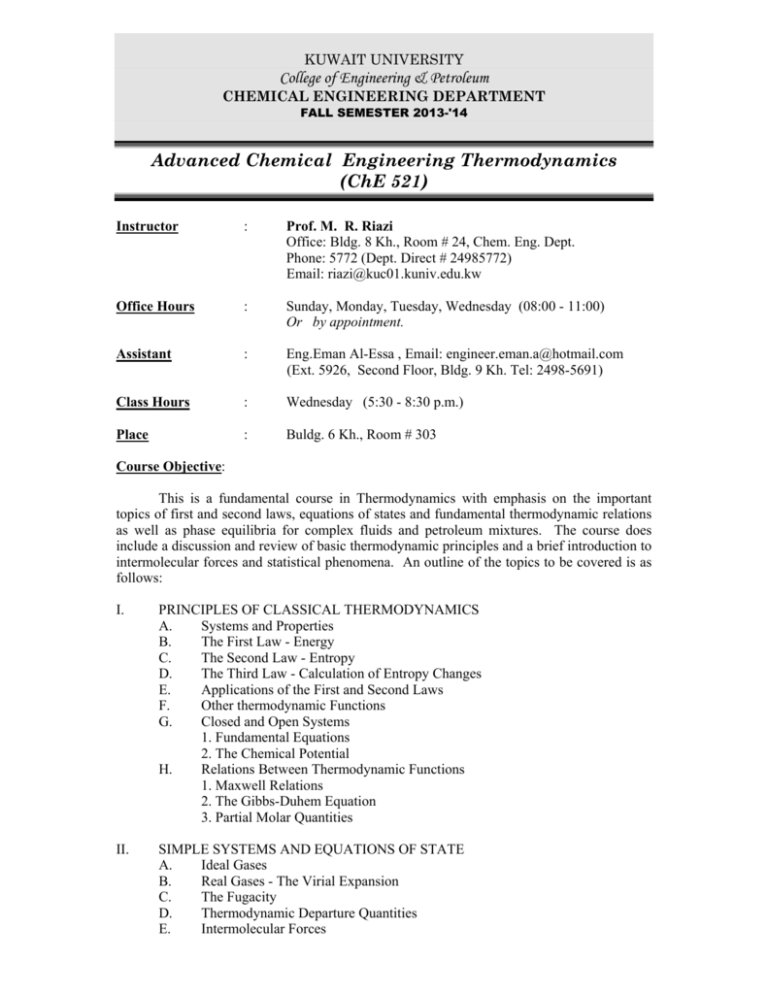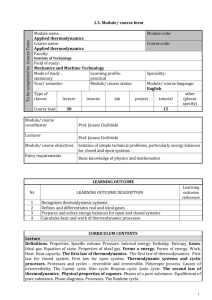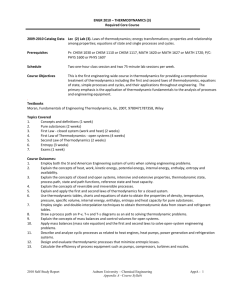Advanced Chemical Engineering Thermodynamics (ChE 521)
advertisement

KUWAIT UNIVERSITY College of Engineering & Petroleum CHEMICAL ENGINEERING DEPARTMENT FALL SEMESTER 2013-'14 Advanced Chemical Engineering Thermodynamics (ChE 521) Instructor : Prof. M. R. Riazi Office: Bldg. 8 Kh., Room # 24, Chem. Eng. Dept. Phone: 5772 (Dept. Direct # 24985772) Email: riazi@kuc01.kuniv.edu.kw Office Hours : Sunday, Monday, Tuesday, Wednesday (08:00 - 11:00) Or by appointment. Assistant : Eng.Eman Al-Essa , Email: engineer.eman.a@hotmail.com (Ext. 5926, Second Floor, Bldg. 9 Kh. Tel: 2498-5691) Class Hours : Wednesday (5:30 - 8:30 p.m.) Place : Buldg. 6 Kh., Room # 303 Course Objective: This is a fundamental course in Thermodynamics with emphasis on the important topics of first and second laws, equations of states and fundamental thermodynamic relations as well as phase equilibria for complex fluids and petroleum mixtures. The course does include a discussion and review of basic thermodynamic principles and a brief introduction to intermolecular forces and statistical phenomena. An outline of the topics to be covered is as follows: I. PRINCIPLES OF CLASSICAL THERMODYNAMICS A. Systems and Properties B. The First Law - Energy C. The Second Law - Entropy D. The Third Law - Calculation of Entropy Changes E. Applications of the First and Second Laws F. Other thermodynamic Functions G. Closed and Open Systems 1. Fundamental Equations 2. The Chemical Potential H. Relations Between Thermodynamic Functions 1. Maxwell Relations 2. The Gibbs-Duhem Equation 3. Partial Molar Quantities II. SIMPLE SYSTEMS AND EQUATIONS OF STATE A. Ideal Gases B. Real Gases - The Virial Expansion C. The Fugacity D. Thermodynamic Departure Quantities E. Intermolecular Forces III. PHASE EQUILIBRIA AND MIXTURES A. General Mixture Problem B. Ideal Solutions C. Solution Equilibria IV. HEAT EFFECTS A. Heat of Formation B. Heat of Reaction C. Heat of Combustion D. Effects of Temperature Grading: The course grade will be based (approximately) on the following considerations : Mid-Term Exam Final Exam Homework & Other Assignments : : : 35% 45% 20% Main References: 1. Prausnitz, J.M., Lichtenthaler, R.N., de Azevedo, E.G. "MOLECULAR THERMODYNAMICS OF FLUID-PHASE EQUILIBRIA", Third edition, PrenticeHall, Inc., 1998. 2. Riazi, M. R. "Characterization and Properties of Petroleum Fractions", 1st edition, Conshohocken, PA, ASTM International, 2007 (www.astm.org/mnl50). [Chapters 5, 6, 7 and 9 will be used in this course.] FIRST SEMESTER 2012-13 Advanced Chemical Engineering Thermodynamics (ChE 521) Main References: 1. Prausnitz, J.M., Lichtenthaler, R.N., de Azevedo, E.G. "MOLECULAR THERMODYNAMICS OF FLUID-PHASE EQUILIBRIA", Third edition, PrenticeHall, Inc., 1998. 2. Riazi, M. R. "Characterization and Properties of Petroleum Fractions", 1st edition, Conshohocken, PA, ASTM International, 2007 (www.astm.org/mnl50). [Chapters 5, 6, 7 and 9 will be used in this course.] 3. Denbigh, K. "THE PRINCIPLES OF CHEMICAL EQUILIBRIUM", 5th edition, London, Cambridge University Press, 1992. [Chapters 1-2 and 11-13 will be used in this course.] 4. Model, M., Reid, R.C. "THERMODYNAMICS AND ITS APPLICATIONS", 3rd edition, Prentice-Hall, 1996. [Chapters 1-8, Chapter 11]. Supplementary References: 1. Lewis, G.N. and M. Randall, "THERMODYNAMICS", McGraw-Hill, New York. A classical reference for chemical thermodynamics at the advanced undergraduate or graduate level. 2. Smith, J.M. , H.C. Van Ness and M. Abbott, "INTRODUCTION TO CHEMICAL ENGINEERING THERMODYNAMICS", 6th Edition, McGraw-Hill, 2000. The most widely used undergraduate chemical engineering thermodynamics textbook. Excellent for basic principles of classical thermodynamics. 3. Hill,T.L.,"INTRODUCTION TO STATISTICAL THERMODYNAMICS". Rather stiff reading but gives a comprehensive coverage. 4. Kyle, B.G., "CHEMICAL AND PROCESS THERMODYNAMICS" Prentice Hall, 1999. 3rd Edition, COURSE CONTENTS I. PRINCIPLES OF CLASSICAL THERMODYNAMICS A. Systems and Properties B. The First Law - Energy C. The Second Law - Entropy D. The Third Law - Calculation of Entropy Changes E. Applications of the First and Second Laws F. Other thermodynamic Functions G. Closed and Open Systems 1. Fundamental Equations 2. The Chemical Potential H. Relations Between Thermodynamic Functions 1. Maxwell Relations 2. The Gibbs-Duhem Equation 3. Partial Molar Quantities II. SIMPLE SYSTEMS AND EQUATIONS OF STATE A. Ideal Gases B. Real Gases - The Virial Expansion C. The Fugacity D. Thermodynamic Departure Quantities E. Intermolecular Forces III. PHASE EQUILIBRIA AND MIXTURES D. General Mixture Problem E. Ideal Solutions F. Solution Equilibria IV. HEAT EFFECTS E. Heat of Formation F. Heat of Reaction G. Heat of Combustion H. Effects of Temperature V. STATISTICAL THERMODYNAMICS A. The Relation Between Entropy and Randomness B. Partition Functions C. Thermodynamic Functions in Terms of Partition Functions D. Results for Crystals, Ideal Gases APPENDIX: Appendix A - Notes Note # 1 Note # 2 Note # 3 Note # 4 : : : : Clarification of Second Law Entropy & Irreversibility Useful Mathematical Relations Thermodynamic Property Changes







